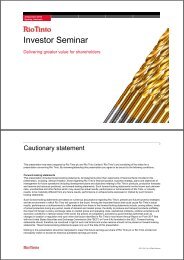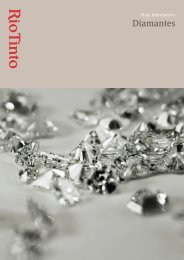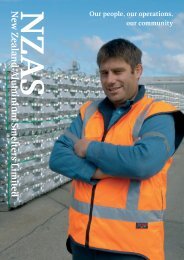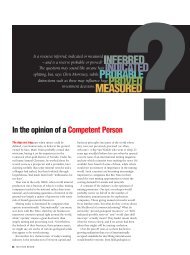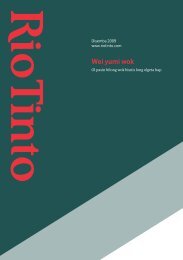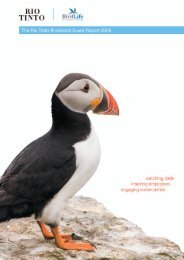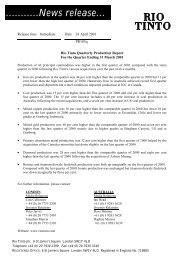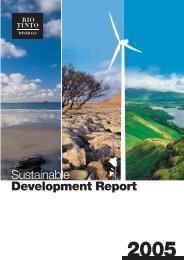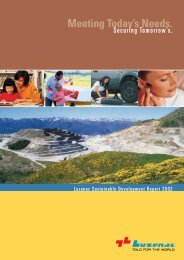Download pdf file [PDF: 1.26 MB] - Rio Tinto
Download pdf file [PDF: 1.26 MB] - Rio Tinto
Download pdf file [PDF: 1.26 MB] - Rio Tinto
You also want an ePaper? Increase the reach of your titles
YUMPU automatically turns print PDFs into web optimized ePapers that Google loves.
<strong>Rio</strong> <strong>Tinto</strong> North America<br />
Analyst Tour<br />
Borates for the New Millenium<br />
• Alarms<br />
• Emergency exits<br />
• Personal protective equipment<br />
• Site specific hazards<br />
• Questions?<br />
Boron Operations<br />
September 23, 2002<br />
Safety
• Preston Chiaro, President and CEO<br />
• Chris Robison, Operations<br />
• David Peever, Sales & Marketing<br />
• Gordon Hamilton, Business Development<br />
<strong>Rio</strong> <strong>Tinto</strong><br />
Iron Ore<br />
Copper<br />
Aluminium<br />
Gold & Other Minerals<br />
Energy<br />
Industrial Minerals<br />
Luzenac Group<br />
Dampier Salt<br />
Iron & Titanium<br />
Borax<br />
Presentation team<br />
<strong>Rio</strong> <strong>Tinto</strong> Borax
Preston Chiaro<br />
President and CEO<br />
David Peever<br />
Sales & Marketing<br />
Chris Robison<br />
Operations<br />
Gordon Hamilton<br />
Business Development<br />
Paul Zerella<br />
Technology<br />
Jeff Olsen<br />
Finance<br />
• Market leader (supplier of choice)<br />
• Strategy focused<br />
• Competitive<br />
• Increased appetite for taking calculated risks<br />
• Hungry for growth<br />
• Cost-conscious<br />
• Excellent reputation<br />
Steve Saperstein<br />
Human Resources<br />
Mike Stockman<br />
General Counsel<br />
Alexis Fernandez<br />
Communications and Communities<br />
Jim Qin<br />
Environment, Health and Safety<br />
Ed Docks<br />
Business Improvement<br />
Borax organization<br />
What is Borax?
World-wide facilities<br />
Mines/Refineries/Terminals<br />
• Boron, USA<br />
• Wilmington, USA<br />
• Salta, Argentina (4 mines plus<br />
refinery)<br />
• Coudekerque, France<br />
• Rotterdam, Netherlands<br />
• Valencia, Spain<br />
• Monfalcone, Italy<br />
• Pusan, South Korea<br />
• Kaoushiung, Taiwan<br />
• Port Klang, Malaysia<br />
Corporate/Sales Technical Support<br />
• U.S. Borax, Valencia, USA<br />
• Borax Argentina, Argentina<br />
• Borax Brasil, Brazil<br />
• Borax Benelux, Belgium<br />
• Deutsche Borax, Germany<br />
• Borax España - Spain<br />
• Borax Europe, UK<br />
• Borax Francais - France<br />
• Borax Italia - Italy<br />
• Borax Asia - Singapore<br />
• Borax Asia - Beijing<br />
• Borax Asia - Shanghai<br />
• Borax Asia - Guangzhou<br />
Warehouses (not shown)<br />
• Austria<br />
• Germany<br />
• Norway<br />
• Russia<br />
• Ukraine<br />
• United Kingdom<br />
Borax principal products<br />
B2O3 Production<br />
Sodium Borates Content (%) Ranges, ‘000 tpa Principal Uses<br />
Borax Decahydrate 38 60-90 Cleaning<br />
(10 Mol)<br />
Borax Pentahydrate 49 700-900 IFG, Detergents,<br />
(5 Mol) Agriculture<br />
Anhydrous Borax 69 20-30 Borosilicate<br />
Glass, Enamel<br />
Non Sodium Borates<br />
Boric Acid 56 160-250 TFG, Ceramics,<br />
Chemicals<br />
Anhydrous Boric Acid 99 5-10 Specialty glass
Strengths<br />
• Long-life, low cost, world-class ore<br />
bodies and refining facilities<br />
• Customer focus<br />
• Knowledge (global borate<br />
resources, chemistry, R&D,<br />
technical support, etc.)<br />
• <strong>Rio</strong> <strong>Tinto</strong> synergies<br />
Opportunities<br />
• Borate end use protection and<br />
growth by exploiting unique<br />
physical, chemical, biological, and<br />
nuclear properties of boron<br />
• Continuing cost efficiency gains<br />
• Improving customer value in use<br />
200<br />
150<br />
100<br />
50<br />
0<br />
Borax SWOT matrix<br />
Weaknesses<br />
• Slow inherent growth rate of traditional end<br />
use markets<br />
• Logistics cost disadvantages<br />
• Size of ore reserves relative to Eti<br />
• Difficult to grow by acquisition<br />
Threats<br />
• Price pressures (driven by competitor<br />
expansion desires)<br />
• Customer buying power (global,<br />
concentrated markets)<br />
• Product substitution<br />
Indexed sales and earnings<br />
(1993 = 100)<br />
1993 1994 1995 1996 1997 1998 1999 2000 2001<br />
Earnings Sales<br />
Recent performance
• Defend markets<br />
– Protect against inappropriate regulation<br />
– Minimize substitution<br />
• Stimulate intensity of use (tons per million)<br />
– United States: 1,400<br />
– Germany: 1,200<br />
– China: 90<br />
• Stimulate new uses<br />
Mission, strategy and values<br />
Secure markets
• Differentiate product and service package to provide<br />
outstanding value proposition for our customers<br />
– Reliability<br />
– Quality (ISO 9000)<br />
– Continuous product improvements<br />
– Technical support<br />
– Efficient and flexible distribution<br />
• Maximize conversions of minerals to refined products<br />
• Establish and nurture long term partnerships<br />
• Maintain industry leadership<br />
Secure market share<br />
Secure resources<br />
• Human resources<br />
– Safety<br />
> Visible, heartfelt executive leadership<br />
> Focus on safe behaviors (SMAT) and increase involvement<br />
and accountability of workers<br />
– Competence<br />
– Accountability (scorecards)<br />
– Talent management (leadership review)<br />
• Natural resources<br />
– Optimize use of various ore types at Boron<br />
– Rational use of borate sources in South America<br />
– Exploration<br />
> Unified with <strong>Rio</strong> <strong>Tinto</strong> Exploration<br />
> Goal - find the next world class sodium borate deposit (20+<br />
year development lead time)
• Business improvement initiatives<br />
– Revenue enhancement<br />
– Cost and productivity review<br />
– Capital spending<br />
– Performance management<br />
• Revenue enhancement<br />
– Mineral conversions<br />
– Alliances<br />
– Rigorous customer segmentation<br />
– Added value borate product<br />
– Perborate defense<br />
– Integrated distribution logistics<br />
– Improve South America options<br />
– Develop emerging agriculture markets<br />
Secure profits<br />
Secure profits
• Cost and productivity review<br />
– Patterned after McKinsey TOP/Comalco PEP<br />
– Target 40 percent reduction in compressible costs<br />
– 28 work units cover all departments and people<br />
– Over 700 ideas selected to be implemented<br />
– On track for overall 20 percent cost reduction<br />
– Two year implementation window<br />
• Rigorous capital spending process<br />
• Performance management system<br />
– Patterned on “balanced scorecards”<br />
– Identify key value drivers for business<br />
> Corporate “dashboard”<br />
> Diagnostic<br />
> Leading and lagging<br />
– Target setting principles<br />
– Consequence management<br />
– Signed performance “contracts” for all employees<br />
Secure profits<br />
Secure profits
• Safety factors<br />
– LTIFR<br />
– AIR<br />
– Severity<br />
• Business performance factors<br />
– After tax earnings<br />
– EACC<br />
– Overall business NPV<br />
• Other factors<br />
– Performance management rollout<br />
– Cost savings<br />
– Cooperation with other <strong>Rio</strong> <strong>Tinto</strong> business units<br />
– Realization of value from new applications<br />
– Demonstrate business case for sustainable development<br />
• Sustainable development - Development that meets the<br />
needs of the present generation without undermining the<br />
capacity of future generations to meet their needs<br />
– Planet<br />
• ISO 14001 certification at all sites<br />
• Regulatory compliance provides foundation<br />
– People<br />
• Mutual respect<br />
• Active partnership<br />
• Long-term commitment<br />
• Global coordination, local focus<br />
– Profits<br />
• Sustain healthy economic performance<br />
My scorecard<br />
Secure reputation
100%<br />
80%<br />
60%<br />
40%<br />
20%<br />
0%<br />
Sustainable Development<br />
Sustainable development principles<br />
Which Borax initiatives do opinion leaders<br />
want to know more about?<br />
58% 57% 52% 52% 50% 45%<br />
Product innovation/R&D<br />
Environ activities/policies<br />
Exploration practices<br />
Technical support<br />
Rel'ship w/ <strong>Rio</strong> <strong>Tinto</strong><br />
Who cares?<br />
More info
What’s in it for Borax?<br />
• Gain competitive advantage through new approach to product<br />
design and borate applications<br />
• Differentiate Borax from the competition<br />
• Enhance Borax’s (and the industry’s) reputation<br />
• Reduce risks and costs of uncertainties<br />
• Provide comprehensive framework to guide employee<br />
decision-making<br />
• Secure society’s continued approval to operate<br />
Sustainable development mission:<br />
How does it work?<br />
To ensure that Borax operations and products contribute to sustainable<br />
development
What are we trying to accomplish?<br />
• Objectives<br />
– To protect the safety and health of employees, contractors,<br />
neighboring communities and the public<br />
– To enhance the human potential and well-being of<br />
communities and employees<br />
– To maximize efficient utilization of resources while minimizing<br />
environmental impacts of our operations<br />
– To optimize our economic contribution to society<br />
– To expand how our products contribute to sustainable<br />
development<br />
• Sharp focus on safety performance<br />
• Retain market leader position<br />
• Strategy-focused, driven management team<br />
• Increasingly competitive environment<br />
• Increased appetite for taking on calculated risks<br />
• Growth through added customer value and new end uses<br />
• Attention to costs<br />
• Maintain reputation<br />
Summary
Boron<br />
Wilmington<br />
Chris Robison<br />
Operations Overview<br />
Borax<br />
Francais<br />
Borax<br />
Espana<br />
Borax<br />
Rotterdam<br />
Borax<br />
Argentina<br />
World-wide operations<br />
Kuala Lumpur<br />
(Transloader)<br />
Pusan<br />
(Transloader)<br />
Kaohsiung<br />
(Transloader)
Boron Operations<br />
Wilmington
Borax Rotterdam<br />
Borax Français
Nules<br />
Valencia<br />
Borax España<br />
Borax Argentina
40<br />
35<br />
30<br />
25<br />
20<br />
15<br />
10<br />
5<br />
0<br />
1996 1997 1998 1999 2000 2001 2002 YTD<br />
Ongoing initiatives<br />
• SMAT process<br />
• Near-miss reporting<br />
• Fitness for duty<br />
• Drug and alcohol testing<br />
• Post injury management<br />
Headcount<br />
1100<br />
1000<br />
900<br />
800<br />
700<br />
600<br />
500<br />
Injury trend - Borax Operations<br />
Lost Time Injuries<br />
Total Injuries<br />
Boron Efficiencies 1982 to 2004<br />
1982<br />
1983<br />
1984<br />
1985<br />
1986<br />
1987<br />
1988<br />
1989<br />
1990<br />
1991<br />
1992<br />
1993<br />
1994<br />
1995<br />
1996<br />
1997<br />
1998<br />
1999<br />
2000<br />
2001<br />
2002<br />
2003<br />
2004<br />
2005<br />
2006<br />
2007<br />
Headcount Tons B203 per Manhour<br />
0.55<br />
0.50<br />
0.45<br />
0.40<br />
0.35<br />
0.30<br />
0.25<br />
Tons B203 per Manhour
Headcount<br />
Headcount<br />
36<br />
34<br />
32<br />
30<br />
28<br />
26<br />
24<br />
22<br />
20<br />
100<br />
90<br />
80<br />
70<br />
60<br />
50<br />
40<br />
Rotterdam<br />
1996 1997 1998 1999 2000 2001<br />
Headcount - Rotterdam B2o3 Tons per manhour - Rt<br />
Spain<br />
130<br />
125<br />
120<br />
115<br />
110<br />
105<br />
100<br />
95<br />
90<br />
85<br />
80<br />
1996 1997 1998 1999 2000 2001<br />
Headcount<br />
Headcount - Spain B2o3 Tons per manhour - S<br />
Headcount<br />
1.600<br />
1.400<br />
1.200<br />
1.000<br />
0.800<br />
0.600<br />
0.400<br />
0.200<br />
Tons B2O3 per<br />
manhour<br />
France<br />
1996 1997 1998 1999 2000 2001<br />
400<br />
350<br />
300<br />
250<br />
200<br />
150<br />
100<br />
50<br />
0<br />
339<br />
Headcount - France B2o3 Tons per manhour - Fr<br />
8.000<br />
7.000<br />
6.000<br />
5.000<br />
4.000<br />
3.000<br />
2.000<br />
Tons B2O3 per manhour<br />
358<br />
337<br />
Argentina<br />
316<br />
240<br />
Efficiencies<br />
0.080<br />
0.070<br />
0.060<br />
0.050<br />
0.040<br />
0.030<br />
0.020<br />
0.010<br />
1995 1996 1997 1998<br />
Years<br />
1999 2000 2001<br />
Employees Tons B2O3/Manhour<br />
Tons B2O3 per manhour<br />
Efficiencies<br />
230<br />
195<br />
0.12<br />
0.1<br />
0.08<br />
0.06<br />
0.04<br />
0.02<br />
0<br />
Tons B2o3 per manhour
<strong>Rio</strong> <strong>Tinto</strong> Borax - Boron deposit statistics<br />
• Original resource 230 million tons of sodium borates<br />
• Underground mine opened in 1927 (9 million tons)<br />
• Open pit mining since 1957 (101 million tons)<br />
• 113 million tons of mineable sodium borate reserves* remain<br />
• Deposit also contains 123 million tons of mineable<br />
sodium/calcium borate reserves for future use<br />
*As per JORC Code<br />
Boron Mine Operations production information<br />
Ore mining rate 3 million tons/year<br />
Overburden mining rate 58 million tons/year (‘02 - ‘07)<br />
Mine redevelopment/capitalized Over 16:1 strip ratio<br />
Remaining mine life strip ratio 20.4 : 1<br />
Ore grade Tincal 25.3% B 2 O 3<br />
Kernite 31.9% B 2 0 3
Tons (000's)<br />
120,000<br />
100,000<br />
80,000<br />
60,000<br />
40,000<br />
20,000<br />
0<br />
1996<br />
1997<br />
P&H 4100 (tons/hr)<br />
6500<br />
6000<br />
5500<br />
5000<br />
4500<br />
4000<br />
3500<br />
3000<br />
2500<br />
2000<br />
1998<br />
1999<br />
2000<br />
2001<br />
2002<br />
2003<br />
2000 2001 2002 2003 2004 2005 2006<br />
2004<br />
TPH P&H 4100's Shovel Industry Avg.<br />
TPH Unit Rig 240-T Trucks Truck Industry Avg.<br />
•2 P&H 4100 Electric Rope shovels<br />
•1 Liebherr 996 Hydraulic Shovel<br />
•2 Loaders (LeTourneau L1400 and L1350)<br />
•25 Terex Unit Rig 4400<br />
•1 x 16g Grader<br />
•2 x 24g Grader<br />
•4 x D11 Dozers<br />
•2 x DK55 Drills<br />
Waste stripping<br />
Stripping Average Stripping<br />
2005<br />
2006<br />
2007<br />
Mine productivity<br />
950<br />
850<br />
750<br />
650<br />
550<br />
Unit Rig 4400 (tons/hr)
Plan<br />
Ideas<br />
Individual<br />
Projects<br />
Cost<br />
Reduction<br />
19%<br />
EHS<br />
14%<br />
Project<br />
Requests<br />
(<strong>PDF</strong>’s)<br />
Prioritize<br />
with Current<br />
Plan<br />
Project<br />
Appropriation<br />
Request<br />
(PAR)<br />
Project<br />
Value<br />
Analysis<br />
(PVA)<br />
2002 CAPEX<br />
Capacity<br />
16%<br />
PAR<br />
Draft<br />
Review<br />
Sustaining<br />
51%<br />
Prioritize,<br />
Resource<br />
Allocations<br />
Gate<br />
Capital<br />
Review<br />
Committee<br />
Gate<br />
Project<br />
Appropriation<br />
Approval<br />
EHS<br />
23%<br />
Preliminary<br />
Capital<br />
Plan<br />
Project<br />
Request<br />
(<strong>PDF</strong>)<br />
Project<br />
Implementation<br />
Capital approval process<br />
Gate<br />
Capital<br />
Review<br />
Committee<br />
Out-of-Plan<br />
Ideas<br />
Feedback from<br />
Lessons Learned<br />
Project<br />
Closeout<br />
Meeting<br />
Major<br />
Cost<br />
Reduction<br />
10%<br />
Overhauls<br />
6%<br />
Other<br />
1%<br />
Final<br />
Capital<br />
Plan<br />
Project<br />
Closeout<br />
Project Audits<br />
Capital plan - project type<br />
2003 CAPEX<br />
Capacity<br />
18%<br />
Sustaining<br />
42%
Wilmington<br />
• July 2001 agreement<br />
• Unprecedented 5-year term<br />
• Improved flexibility<br />
– Overtime<br />
– Supervisor’s performing work<br />
– RIF-cost/productivity improvements<br />
Boron<br />
• November 2001 agreement (3-year)<br />
• Significant cost/productivity improvements<br />
– Pyramiding of overtime eliminated<br />
– Fitness for duty program<br />
– Product packing - outside Boron<br />
– 12-hour shifts - mine operation<br />
12-hour shift benefits<br />
• Eliminated one shift change/lunch break<br />
• Reduced overtime - 30%<br />
– Unscheduled<br />
– Working lunch<br />
• Productivity<br />
– Shutdown/start-up<br />
– Crew alignment<br />
– Communications<br />
• Equipment reduction<br />
– 1 shovel<br />
– 2 loaders<br />
– 8 haulage trucks<br />
• Fatigue<br />
– Overtime - day off only<br />
– Improved time off<br />
Labor contracts<br />
Labor
Key Negotiations Message<br />
“We have, and will continue to, provide good wages and benefits, but we must in return achieve cost<br />
and productivity improvements and flexible work practices.”<br />
Short Term<br />
• Creating a culture around performance<br />
management<br />
- Consistency<br />
- Accountability<br />
- Reliability<br />
- Efficiency<br />
• Consistent application of processes by<br />
supervisors<br />
- Attendance<br />
- Corrective Action<br />
- Overtime<br />
- Drug and Alcohol Testing<br />
• Upgrading and evaluating talent pool<br />
• Imbedding continuous improvement as a<br />
way of business<br />
Long Term<br />
Group-wide initiatives<br />
• Additional cost reductions - 10% over 3 years<br />
• Rationalization and consolidation<br />
– Wilmington/Coudekerque/Boron<br />
• Zinc borate capacity<br />
Boron<br />
• Boric acid capacity<br />
• Mine optimization<br />
• Kernite hydration/alternatives<br />
Spain<br />
• Port changes - Valencia to Castillion<br />
Argentina<br />
• Boric acid plant<br />
• Furnace modernization<br />
• Mine planning<br />
• Tincalayu dry plant<br />
• Creating a culture of interdependence.<br />
– Increased use of teams and crossfunctional<br />
groups<br />
• Position ourselves to achieve more flexibility<br />
in work practices<br />
– Increased flexibility in job assignments<br />
– Minimization of restrictive work<br />
practices<br />
• Levels of work properly focused<br />
• Application of sustainable development<br />
principles and philosophies<br />
Labor<br />
Looking ahead
Commercial Director<br />
Europe<br />
David Peever<br />
World Borate Market Outlook<br />
Commercial Manager<br />
South America<br />
General Sales Manager<br />
North America<br />
Global Technical<br />
Service Manager<br />
Global Strategy<br />
Manager<br />
Chief Commercial Officer<br />
Global Distribution<br />
Manager<br />
Global commercial organization<br />
General Manager<br />
Borax Asia<br />
Global Business Manager<br />
Forest Products<br />
Global Marketing<br />
Manager<br />
Global Business Manager<br />
Agriculture<br />
Global Business Manager<br />
Fiberglass Products
2001 2002 2003 2004 2005 2006<br />
Total B 2 O 3 (KMT) 1,190 1,180 1,210 1,250 1,270 1,300<br />
(rounded to nearest 10kmt)<br />
Estimated total B 2 O 3 market - the outer years<br />
Percent change -.8% 2.5% 3.3% 1.6% 2.2%<br />
Agriculture<br />
7%<br />
Ceramics<br />
14%<br />
Detergents<br />
12%<br />
2001<br />
Source: RTB sales & publicly available data<br />
Others<br />
26%<br />
Borosilicate<br />
Glass<br />
8%<br />
Estimated world end use demand for borates<br />
2001 & 2006<br />
TFG<br />
15%<br />
IFG<br />
18%<br />
Agriculture<br />
7%<br />
Ceramics<br />
15%<br />
Detergents<br />
9%<br />
Source: RTB sales & publicly available data<br />
2006<br />
Other<br />
28%<br />
Borosilicate<br />
Glass<br />
8%<br />
TFG<br />
15%<br />
IFG<br />
18%
IMCC<br />
6%<br />
S America<br />
7%<br />
AB & Other<br />
(RTB, IMCC)<br />
10%<br />
BA (RTB)<br />
21%<br />
Estimated global borate sales by mine source<br />
2001 data<br />
Russia<br />
4%<br />
Eti Bor<br />
32%<br />
1,190 B 2 O 3 kmt<br />
China<br />
7%<br />
Source: RTB sales & publicly available data<br />
10 Mol (China)<br />
9%<br />
Source: RTB sales & publicly available data<br />
Minerals (Eti)<br />
22%<br />
Borax<br />
44%<br />
Estimated world borate market<br />
B 2 O 3 product basis (largest supplier)<br />
5 Mol (RTB)<br />
38%
23%<br />
34%<br />
9%<br />
10%<br />
N America<br />
419kmt B2O3<br />
5%<br />
Estimated regional market share - 2001<br />
62%<br />
51%<br />
Europe<br />
441kmt B2O3<br />
4% 4%<br />
5%<br />
Borax Eti Bor IMCC S America FSU<br />
Source: RTB sales & publicly available data<br />
Asia Pacific<br />
230kmt B2O3<br />
5%<br />
8%<br />
36%<br />
Estimated regional market share - 2001<br />
32%<br />
12%<br />
47%<br />
3%<br />
International<br />
100kmt B2O3<br />
Borax Eti Bor IMCC S America FSU PRC<br />
Source: RTB sales & publicly available data<br />
3%<br />
17%<br />
30%
1998 1999 2000 2001<br />
Refined 160 196 178 190<br />
Minerals 231 212 202 181<br />
Source: Eti annual report & publicly available data<br />
• Moderate demand growth<br />
• New competitive capacities<br />
• Move away from minerals<br />
• Perborate substitution<br />
• Selling value<br />
• The pricing imperative<br />
• The economy<br />
Eti moving to refined<br />
Estimated volume (kmt B 2 O 3 )<br />
Key strategic issues
• Customer segmentation<br />
• Mineral conversions<br />
• Service offerings/sell value<br />
• Aligned, focused organization<br />
• Management processes<br />
• Efficient distribution channels<br />
• Maintain status as market leader<br />
Secure market share
Gordon Hamilton<br />
Growth Through New Applications<br />
The challenges facing <strong>Rio</strong> <strong>Tinto</strong> Borax<br />
Threats to maintaining value<br />
– Mature end uses with modest growth prospects<br />
– Traditional end uses under increasing competition<br />
– Some end uses are facing reformulation or substitution<br />
Opportunities to build value<br />
– Generate new business areas for borates - secure markets<br />
– Defend mainstream businesses<br />
– Reduce costs
Generate incremental borate sales worth 25% of current<br />
revenue per annum by 2010, and a further 25% of current<br />
revenue for each subsequent 10-year period<br />
Mission<br />
Business Development approach<br />
• We invest ~2% of turnover in our development efforts<br />
• We are structured as a separate ‘hot house’ unit, transferring<br />
young business to mainstream sales<br />
• We stimulate idea generation from all sources, both internal and<br />
external<br />
• We instill rigor and objectivity through a stage / gate process<br />
• Executive involvement and good process allows a balance<br />
between creativity and a ‘grow or kill’ ethos<br />
• We will secure value for Borax through use of technology and<br />
intellectual property protection
Horizon 3 Horizon 2 Horizon 1<br />
Idea generation<br />
and evaluation<br />
Faster time to market of all projects in the pipeline<br />
Increased emphasis on getting high profit projects to<br />
market<br />
Disciplined prioritization of the portfolio; kill/idle<br />
projects with low technical or market feasibility<br />
Ensure all projects with significant potential are<br />
resourced to move forward quickly<br />
Some current activities:<br />
• Pulp and paper<br />
• Ceramics<br />
• Wood protection of<br />
residential housing<br />
• Hydrogen storage/fuel cell<br />
Validation, development<br />
and launch<br />
Process overview<br />
Full transfer to sales +<br />
marketing<br />
Areas already delivered:<br />
• Textile fiber glass gains<br />
Growth sectors<br />
• Borates as wood preservatives<br />
• Polymer additives<br />
• Gypsum board<br />
• Steel
Concept<br />
Chemical recovery in pulp production<br />
• Add borates into the pulping chemical recycle stream to reduce<br />
raw material costs and energy usage<br />
• Patented technology<br />
• Initial target is kraft mills with chemical recovery limitations<br />
• Market potential assessed as 50kmt B 2 O 3<br />
Initiatives<br />
• Formed joint development team with Luzenac North America to<br />
build speed to market<br />
• Technical credibility built with the industry<br />
• Trials at several majors started – more to come this year<br />
Concept<br />
Ceramic tile bodies<br />
• Add borates into the ceramic tile body to reduce raw material cost<br />
and energy usage<br />
• Unique double functionality identified – fluxing, dry strength<br />
increase<br />
• High market potential – equal to 150kmt B 2 O 3<br />
Initiatives<br />
• Formed joint development efforts with frit producers to build<br />
speed to market<br />
• Strong value propositions identified: >10% reduction in costs<br />
possible<br />
• One customer commercialised<br />
• Trials at several majors starting
Concept<br />
Borates in residential wood construction<br />
• Improve durability and value of residential construction.<br />
• Initial target - ‘high hazard’ regions in the USA<br />
• Good market potential – equal to 70kmt B 2 O 3<br />
• Builder improves profit, image and reduces call backs<br />
• Home buyer get more durable, bug free home<br />
• Building products supplier increased margins<br />
Initiatives<br />
• Formed joint development efforts with building products groups<br />
to build speed to market<br />
• Strong value propositions identified: $1.5 - $2 per sq ft add on<br />
cost to home buyer<br />
• Two construction projects confirmed (>1,000 homes)<br />
• Up scale production builders being courted<br />
High hazard<br />
Moderate hazard<br />
Low hazard<br />
Over 40% of all new homes are built in the<br />
high termite and decay hazard area<br />
Target regions
Concept<br />
Hydrogen storage for fuel cells<br />
• Solves problem of hydrogen storage for transportation, personal<br />
electronics, portable, and back-up power<br />
• Sodium borohydride<br />
– high storage density<br />
– safe<br />
– recyclable<br />
• Market potential is massive (many times current B 2 O 3 sales)<br />
Initiatives<br />
• Joint Development Agreement with Millennium Cell to bring price<br />
of borohydride in line with public expectations<br />
• Daimler Chrysler Natrium minivan demonstrated on open road,<br />
300 mile range with no incursion of fuel system into cabin<br />
• Long-range, high potential project adds diversity to BD portfolio<br />
• Balance of risk vs. potential<br />
We are prepared to:<br />
• Form alliances to accelerate growth<br />
• Share market knowledge<br />
• Share technical know-how and development<br />
• Share intellectual property<br />
• Share market value<br />
• Assume greater (but fully considered) risk<br />
• Have more failures than successes to build incremental business<br />
for Borax as fast as possible
RIO TINTO BORAX<br />
Background<br />
<strong>Rio</strong> <strong>Tinto</strong> Borax operates California’s largest open pit mine in Boron, California – one of two worldclass<br />
borate deposits. The company supplies nearly half the world’s demand for refined borates.<br />
Borax traces its roots to California’s Death Valley, where borate deposits were discovered in 1872.<br />
Today, Borax is acknowledged as the world leader in borate technology, research and<br />
development; and an industry leader in efforts to measure and improve the social, environmental<br />
and economic impacts of its products and practices.<br />
Borax is a wholly-owned subsidiary of <strong>Rio</strong> <strong>Tinto</strong> plc.<br />
Commercial Overview<br />
� Customers in nearly 100 countries<br />
� Sales in the half billion dollar per annum range<br />
� Global market share of about 43%; steady for the past four years<br />
� Global borate market = 41% insulation fiberglass, textile fiberglass and heat-resistant glass;<br />
13% ceramic and enamels frits and glazes, tile bodies; 12% detergents, soaps and personal<br />
care products; 6% plant fertilizers; 28% other uses, including flame retardants and wood<br />
treatments<br />
� 95% on-time shipping rate, bolstered by Strategic Inventory Placement and long-term contracts<br />
with shippers<br />
� Sales and technical support offices in United States, Argentina, Brazil, Belgium, Germany,<br />
Spain, United Kingdom, France, Italy, Singapore and China<br />
Operations Overview<br />
� Annual production of more than one million tons of refined borates<br />
� Emissions below allowable levels; environmental management system ISO 14001 certified<br />
� 30% reduction in lost-time injury rate; 30% reduction in severity of injuries achieved in 2001<br />
� Quality management systems ISO 9002 certified<br />
U.S. Operations<br />
U.S. Borax Inc., Boron Operations – Borax’s primary mining and refining facility, located in<br />
California’s Mojave Desert.<br />
� 849 employees with an average tenure of more than 15 years (658 hourly)<br />
� Facility recently achieved 1,845,438 hours without a lost-time accident<br />
� Pit measures a mile wide, one and one-half miles long and up to 700 feet deep
� More than 80 different types of minerals found in mine; four main types of borates are tincal,<br />
kernite, ulexite and colemanite<br />
� Mine ore at a rate of about three million tons per year – open pit mining using front end loaders<br />
to mine ore; electric shovels and haul trucks to remove overburden<br />
� Refinery operation produces about one million tons of borax, boric acid and anhydrous<br />
products per annum<br />
� Energy supplied by two cogeneration plants that produce 100 megawatts of electricity, 85 of<br />
which are sold to local utility. One-third of electricity goes to operate pollution control<br />
equipment<br />
� Fleet of nearly 800 rail cars to transport borates to North American customers and central<br />
shipping facility in Wilmington. Principal transportation modes are 71% bulk rail (almost half of<br />
which is exported via bulk and container shipping); 14% ocean containers; 12% trucks; and 3%<br />
piggy-back (truck to rail).<br />
� Product storage capacity of more than 88,000 tons<br />
� Life of operation projected to last at least 75 years<br />
U.S. Borax Inc., Wilmington Operations – Borax’s primary North American shipping facility;<br />
specialty products refining operation, located in the Port of Los Angeles.<br />
� 114 employees with an average tenure of 15 years (94 hourly)<br />
� Facility recently achieved 46,097 hours without a lost-time accident<br />
� Bulk-loading terminal can load up to 1,000 metric tons per hour<br />
� Product storage capacity of 35,000 tons<br />
� Refinery includes five different processing areas and produces 14 high-value specialty<br />
products<br />
� Largest exporter of high-value dry bulk goods out of the Port of Los Angeles; ranks in top ten<br />
shippers of ocean containers through Port of Los Angeles<br />
� Only privately-owned berth in the Port of Los Angeles<br />
South America Operations<br />
Borax Argentina, S.A. – Borax’s primary South American business, operates open pit mines in<br />
Tincalayu, Salta, as well as mines in Sijes, and Porvenir, and refinery facilities in Campo Quijano.<br />
� 180 employees working at Tincalayu mine, Sijes mine, Porvenir mine and Campo Quijano<br />
refinery<br />
� Facility recently achieved 667,283 hours without a lost-time accident<br />
� Tincalayu pit measures 1,500 meters wide, 500 meters long and 100 meters deep<br />
� Main types of borates found in mines are tincal, ulexite, colemanite, hydroboracite and kernite<br />
� Mine ore at a rate of about 100,000 tons per year
� Recent capital commitment of US$2.6 million to build new boric acid plant, built to use tailings<br />
from ulexite concentration operations as feedstock.<br />
� Refinery operation produces Borax TG, Neobor ® A, Dehybor ® A and Boroglas<br />
� Recent capital investments of US$2.4 million to upgrade equipment, including installing new<br />
furnaces, centrifuges and a magnetic concentration plant to improve efficiency and lower<br />
environmental impact.<br />
European Operations<br />
Borax Espana S.A. – packing and distribution facility in Nules, Spain.<br />
� 22 employees with an average tenure of nine years<br />
� More than 10 years without a lost-time accident<br />
� Packing plant, milling plant and warehouse facilities with 14,000 metric ton storage capacity<br />
� Warehouse at Valencia adds another 12,000 metric ton storage capacity<br />
� Strategically located in close proximity to heart of Spanish ceramic industry<br />
� Throughput of 100,000 metric tons per year<br />
� Facility has received eight safety awards from the Spanish Chemical Association in last<br />
decade<br />
Borax Français – refinery and distribution facility in Coudekerque, France.<br />
� 98 employees with an average tenure of 19 years<br />
� Facility recently achieved 91,353 hours without a lost-time accident<br />
� Refinery includes five different processing areas (borax, boric acid and agricultural products)<br />
� Product storage capacity of 3,500 pallets (4,200 metric tons)<br />
Borax Rotterdam, N.V. – Primary European distribution facility in the Port of Rotterdam<br />
� 49 employees working in self-supporting teams<br />
� Facility recently achieved 129,427 hours without a lost-time accident<br />
� A throughput of 260,000 tonnes of product per year<br />
� Costs benchmarked against other companies in the Rhine Delta port; high safety and<br />
environmental performance for comparable costs<br />
� Received 2002 Horti Port Award for outstanding facilities and practices, including community<br />
programs that help disadvantaged people join the mainstream workforce.


![Download pdf file [PDF: 1.26 MB] - Rio Tinto](https://img.yumpu.com/10319684/1/500x640/download-pdf-file-pdf-126-mb-rio-tinto.jpg)
